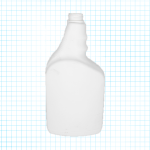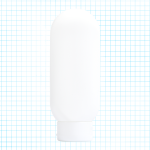When it comes to selecting materials for plastic bottles, you’ll find a wide array of options, each with its unique properties and advantages. The choice of plastic material can significantly impact the performance and suitability of your packaging. In this guide, we’ll delve into various plastic packaging materials commonly used for bottles and their characteristics to help you make informed decisions.
 High-Density Polyethylene (HDPE) #
High-Density Polyethylene (HDPE) #
HDPE stands for High-Density Polyethylene. This dense form of polyethylene is typically used for extrusion blow molding into bottles. HDPE is known for its robustness and resistance to chemicals, making it an excellent choice for packaging applications that involve cleaning solutions, such as wipes and sprays. It’s also commonly used for milk jugs, beverages, and personal care products. While HDPE is less squeezable than some other plastics, it offers durability and reliability. Unlike PET, natural HDPE has a slightly cloudy appearance. Additionally, HDPE is the second most recycled plastic material in the United States, contributing to its sustainability.
 Polyethylene Terephthalate (PET) #
Polyethylene Terephthalate (PET) #
PET, short for Polyethylene Terephthalate, is the most widely used polymer for bottles. It boasts high clarity, which makes it suitable for clear or colored bottle designs. PET is known for its thin-walled, rigid containers that maintain strength, making it an ideal choice for various packaging needs. Its chemical structure allows for lightweight yet durable bottles. PET is also the most recycled plastic resin in the United States. However, it’s worth noting that PET is hygroscopic, meaning it can attract and absorb water. Therefore, it must be dried before melting and molding.
Polypropylene (PP) #
PP, or Polypropylene, is a versatile plastic known for its high-temperature tolerance and excellent oxygen barrier properties. It’s frequently used for airless bottles due to its barrier capabilities. PP resin offers higher clarity than PE but lower clarity than PET. While less PP is recycled compared to PE and PET, its production has a lower environmental impact and emits fewer pollutants. PP is commonly used for products sensitive to oxygen, such as luxury skincare or nutraceutical supplements. It’s also suitable for long-shelf-life formulations, medical products, and food or beverages that may require freezing or microwaving.
 Low-Density Polyethylene (LDPE) #
Low-Density Polyethylene (LDPE) #
LDPE stands for Low-Density Polyethylene and is known for its squeezability when used in bottles or tubes. LDPE bottles are often paired with dispensing closures, allowing users to easily squeeze out the product. Natural LDPE has similar transparency to HDPE but is more translucent. It’s a recyclable material that’s commonly used for various packaging applications.
Less Common Choices (PVC, PS) #
While PVC (Polyvinyl Chloride) and PS (Polystyrene) have been used in the past for bottles, they are less common today due to their environmental impact. Both PVC and PS are challenging to recycle and degrade slowly. PVC, in particular, can contaminate PET recycling streams and harm processing equipment. Additionally, the manufacturing of PVC releases harmful chemicals into the environment. Although you may still encounter PVC bottles in hot-fill applications and PS bottles for disposable purposes, they are generally not recommended for environmentally conscious packaging solutions.
Ultimately, choosing the right plastic material for your bottles depends on various factors, including appearance, functionality, manufacturing location, and environmental impact. COMPAX is committed to helping you meet your specific requirements while considering sustainability and performance in your packaging decisions.




